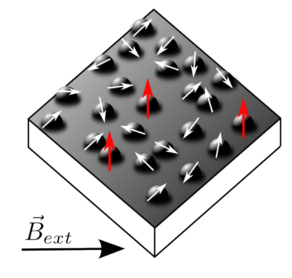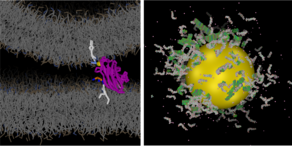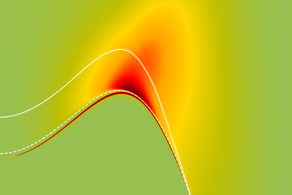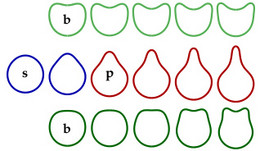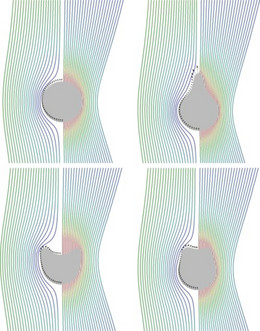DFG Priority Programme SPP1726 "Microswimmers"
Swimming of deformable microcapsules
Jan Kierfeld
students: Horst-Holger Boltz, Hendrik Ender, Christian Wischnewski
Elastic capsules and shells
Elastic shells are thin (quasi two-dimensional) elastic solids in a curved geometry. Of particular interest in soft matter theory and applications are closed spherical elastic shells, which can also be termed elastic capsules and which enclose a liquid of given volume or pressure. On the microscale, capsules have received a lot of attention as delivery systems and as biologically relevant model systems. Prominent examples of biological microcapsules are red blood cells or virus capsules; more generally, all biological cells where a thin layer of elastic cytoskeleton is surrounding the liquid cytosol and participating in deformations can be viewed as elastic capsules. If a coupling to the cytoskeleton is absent, a description of the membrane as a quasi two-dimensional liquid is more appropriate, and we obtain a vesicle rather than a microcapsule. Artificial capsules can be fabricated by various methods, for example, by interfacial polymerization at liquid droplets or by multilayer deposition of polyelectrolytes, and have numerous applications as delivery systems.
Swimming of deformable microcapsules
This research project is focused on the theoretical investigation of self-propelling deformable microcapsule swimmers, which serve as simple model systems for biological cells. Two problems, which occur generically by the interplay of self-propulsion and the resulting hydrodynamic forces and of deformability of such elastic microcapsules will be addressed:
- Because of hydrodynamic forces, a self-propelled or sedimenting microcapsule will deform during swimming, which changes in turn the velocity field of the surrounding fluid and, thus, the resulting swimming velocity. We will develop theoretical and simulation methods in order to calculate the effect of elastic microcapsule deformation on swimming shape and velocity for simple self-propulsion mechanisms by solving the coupled hydrodynamic equations of the fluid and the elastic capsule shape equations simultaneously.
- A deformable microcapsule can use hysteretic shape changes (e.g. snapping or buckling) as a mechanical swimming mechanism. For elastic swimmers with hysteretic shape transitions, completely periodic parameter changes (swelling and shrinking, volume increase and decrease) can give rise to non-time-reversible shape changes. This novel swimming cncept mechanism will be investigated theoretically.
Moreover, capsules can be used as containers to store "fuel". We investigated surfactant-filled capsules which are very effective Marangoni swimmers or surfers at the liquid-air interface. Even if they are spherically symmetric, advection can give rise to spontaneous symmetry breaking and swimming.
References
- Capsules as Marangoni swimmers
- Surfactant-loaded capsules as Marangoni microswimmers at the air–water interface: Symmetry breaking and spontaneous propulsion by surfactant diffusion and advection
H. Ender, A.-K. Froin, H. Rehage, and J. Kierfeld, Eur. Phys. J. E 44, 21 (2021). - From diffusive mass transfer in Stokes flow to low Reynolds number Marangoni boats
H. Ender and J. Kierfeld, Eur. Phys. J. E 44, 4 (2021).
- Surfactant-loaded capsules as Marangoni microswimmers at the air–water interface: Symmetry breaking and spontaneous propulsion by surfactant diffusion and advection
- Swimming by elastic hysteresis
- Swimming, sedimentation, hydrodynamics of elastic capsules

